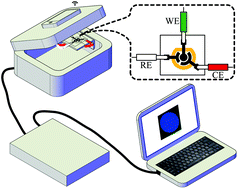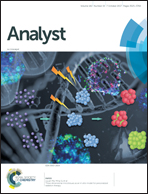An electrochemiluminescence cloth-based biosensor with smartphone-based imaging for detection of lactate in saliva†
Abstract
Cloth fabrics and smartphones have become the two things people are most familiar with. Particularly, smartphones are used as portable personal computers, revolutionizing communication and lifestyle. Here, screen-printing technology is applied to fabricate carbon electrodes and electrochemical chambers on a single hydrophilic cloth, while the cloth-based electrochemiluminescence (ECL) signals are read out by using an inexpensive smartphone. Therefore, the ECL detection is available in both low-cost disposable sensors and a portable format, which may be very suitable to be used as a non-invasive monitoring tool for medical diagnostics. As a proof-of-principle, lactate oxidase is immobilized onto the working electrode for the lactate measurement. Under optimized conditions, the lactate levels can be quantified over the range of 0.05–2.5 mM, with a detection limit of 0.035 mM and the relative standard deviations of 4.7%, 5.2% and 5.0% for 0.05, 0.5 and 2.5 mM lactate (n = 5). In addition, the proposed biosensor has an acceptable stability and selectivity. Finally, the ECL biosensor is successfully applied for the determination of lactate in human saliva. These results show that the presented ECL platform has the potential to be applied to non-invasively detect a variety of analytes of medical interest.



 Please wait while we load your content...
Please wait while we load your content...